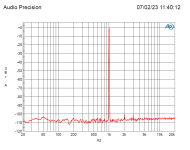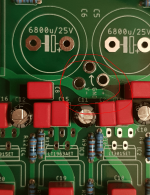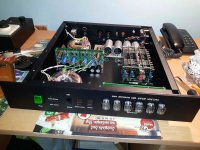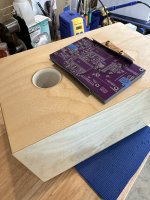I'm talking about much more expensive dacs than this. Which have Spartan 7 in them. Rockna - even more expensive MSB $84,500Come on!! $$$$
https://msbtechnology.com/dacs/reference-features/
It costs so much because they can. This is not rocket science. Everything can be done in the DIY version.
Last edited:
Earlier, while still in stock, we bought some 40 pcs of PCM56K from Rochester.
We also have some 16 pcs AD1862N on hand.
Last weekend, I had a chance to measure their distortion with an Audio Precision SYS2722 distortion analyser.
The DACs were driven directly with a JLSound I2SoverUSB suitably configured.
WAV files used were 16 bit 176.4kHz (4x oversampled).
IV conversion was OPA1612 with 3k Riv to ensure consistent measurements.
The 40+ PCM56s have an output current range of 0.869 ~ 0.899mA.
i.e. 0.884mA +/-0.015mA, or +/-1.7%
All harmonics (H2, H3) were between -99dB and -102dB.
Higher harmonics are all below noise level.
The AD1862s have tighter tolerance.
Current of 16 devices ranges between 0.990 and 0.997mA, or +/-0.3%.
But distortion is also in the same range as PCM56k, i.e. -99dB to -102dB.
And the fine H3 trimming at -60dB does not bring significant improvement.
If you must have perfectly matched output amplitudes, it is super easy to adjust Riv to suit.
For me, PCM56K is just as good as the AD1862.
And there is hardly any difference in noise level.
Of course people will tell you all about subjective impressions.
I'll leave that to them.
🤓
Patrick
.
We also have some 16 pcs AD1862N on hand.
Last weekend, I had a chance to measure their distortion with an Audio Precision SYS2722 distortion analyser.
The DACs were driven directly with a JLSound I2SoverUSB suitably configured.
WAV files used were 16 bit 176.4kHz (4x oversampled).
IV conversion was OPA1612 with 3k Riv to ensure consistent measurements.
The 40+ PCM56s have an output current range of 0.869 ~ 0.899mA.
i.e. 0.884mA +/-0.015mA, or +/-1.7%
All harmonics (H2, H3) were between -99dB and -102dB.
Higher harmonics are all below noise level.
The AD1862s have tighter tolerance.
Current of 16 devices ranges between 0.990 and 0.997mA, or +/-0.3%.
But distortion is also in the same range as PCM56k, i.e. -99dB to -102dB.
And the fine H3 trimming at -60dB does not bring significant improvement.
If you must have perfectly matched output amplitudes, it is super easy to adjust Riv to suit.
For me, PCM56K is just as good as the AD1862.
And there is hardly any difference in noise level.
Of course people will tell you all about subjective impressions.
I'll leave that to them.
🤓
Patrick
.
Attachments
Please try feed the AD1862 with 20bit data, then with 20bit with 1 to 4 bits dither.Earlier, while still in stock, we bought some 40 pcs of PCM56K from Rochester.
We also have some 16 pcs AD1862N on hand.
Last weekend, I had a chance to measure their distortion with an Audio Precision SYS2722 distortion analyser.
The DACs were driven directly with a JLSound I2SoverUSB suitably configured.
WAV files used were 16 bit 176.4kHz (4x oversampled).
IV conversion was OPA1612 with 3k Riv to ensure consistent measurements.
The 40+ PCM56s have an output current range of 0.869 ~ 0.899mA.
i.e. 0.884mA +/-0.015mA, or +/-1.7%
All harmonics (H2, H3) were between -99dB and -102dB.
Higher harmonics are all below noise level.
The AD1862s have tighter tolerance.
Current of 16 devices ranges between 0.990 and 0.997mA, or +/-0.3%.
But distortion is also in the same range as PCM56k, i.e. -99dB to -102dB.
And the fine H3 trimming at -60dB does not bring significant improvement.
If you must have perfectly matched output amplitudes, it is super easy to adjust Riv to suit.
For me, PCM56K is just as good as the AD1862.
And there is hardly any difference in noise level.
Of course people will tell you all about subjective impressions.
I'll leave that to them.
🤓
Patrick
.
You will see diference from pcm56.
I have no music files with 20 bit.
And I am totally fine with -100dB.
Cheers,
Patrick
And I am totally fine with -100dB.
Cheers,
Patrick
PSU 2 not only for AD1862
PSU 2 is based on LT1963A/LT3015 LDO regulators.
Why I chose these regulators? Letting DIY people only on 78/79 regulators would not be fair, so I was searching and found an inspiration in this test:
A-comparative-overview-of-power-supply-regulator-designs-with-listening-tests
In the basic configuration, components are set to output the +/-5VD and +/-12VA for AD1862 DAC.
These regulators are adjustable and are set via resistors and fine tuned using a trimmer.
Again, the output power and heatsink is a DIY question, but since the AD1862 DAC consumption is small, it should go without heatsink
PCB size is 75x150mm and is universal - you can solder components for any other DAC voltages.
It can be cheaply ordered from jlcpcb or any other PCB manufacturer.
(it was not tested at the time of writing this post)
Example list of components (copied from BOM picture, except resistors)
mouser:
603-FMP300FRF73-1R
505-MKP20.01/400/5
R79IC3100Z340J, 505-MKP2D031001FJO00
667-EEU-FR1E101
667-EEU-FR1V271L
647-LKG1V682MESYAK
72-T93YB-2K
72-T93YB-100K, 594-64Y503
72-T93YB-100K
72-T93YB-200K
604-L483GDT
511-1N5822
863-1N4007G
584-LT1963AET#PBF
584-LT3015ET#PBF
534-4628
576-0216001.MXR20SPP
651-1729128
651-1729131
ebay: 233823483402, 233670142926
What is purpose of +V/-V/GND pin holes on PSU 2 of AD1862?
Someone has connected this GND to the chassis earth ground with CL60.
Is it proper usage of this GND pin hole?
Attachments
thanks miro. long time no update, i swapped from pcm63 to tda1540 a few months ago, sound beautiful.

@chi0001 , may I know what is that board connected to the inputs of the DAC?thanks miro. long time no update, i swapped from pcm63 to tda1540 a few months ago, sound beautiful. View attachment 1189561
And the fine H3 trimming at -60dB does not bring significant improvement.
If you must have perfectly matched output amplitudes, it is super easy to adjust Riv to suit.
For me, PCM56K is just as good as the AD1862.
And there is hardly any difference in noise level.
.
I knew iy, my ears didn't mislead me ! PCM56K is in my top 3 with AD1862 and TDA1541A.
So the trimming was not an improvement (high enough to be significant) on the ad1862 VS trimming when checked by ears ? Is it what you are meaning ! Hey, Miro told it !
I was working to incorporate a decent display to the DAC from among these:

But these are power hogs, although they are extremely easy to implement, one is HD44780 compatible (20x4) and other two second from top and bottom one (40x2, 20x2) are three wire serial interface compatible (I have used them with 2 wires GND and Rx). I though of incorporating ILI9341 type while I started working the code for an STM32 based solution, I came across this interesting blog. Hope it could be of use to who want to have a display interface in the DAC.
https://www.dimdim.gr/arduino/universal-usb-to-i2s-interface-indicator/#
But these are power hogs, although they are extremely easy to implement, one is HD44780 compatible (20x4) and other two second from top and bottom one (40x2, 20x2) are three wire serial interface compatible (I have used them with 2 wires GND and Rx). I though of incorporating ILI9341 type while I started working the code for an STM32 based solution, I came across this interesting blog. Hope it could be of use to who want to have a display interface in the DAC.
https://www.dimdim.gr/arduino/universal-usb-to-i2s-interface-indicator/#
I'm a bit confused about the shift register in post #1, I understand why DR is delayed 11 clock cycles, but why is DL delayed 48 clock cycles, shouldn't it be 43? 😵
Why are DL and DR separated by 37 clock cycles instead of 32?
Maybe I'm not getting it right, it's very late here and I'm tired.😴
Why are DL and DR separated by 37 clock cycles instead of 32?
Maybe I'm not getting it right, it's very late here and I'm tired.😴
- Home
- Source & Line
- Digital Line Level
- DAC AD1862: Almost THT, I2S input, NOS, R-2R





